CONNECTION BETWEEN RUSSIA AND INDONESIA: THE HERITAGE OF N.N. MIKLOUHO-MACLAY
Introduction
Indonesia is a rapidly developing Country in Southeast Asia, which is rightfully titled one of the four «New Asian tigers» along with Malaysia, the Philippines and Thailand. However, Indonesia is the largest Island Country in the world and is located on the Islands of the Malay Archipelago and the western part of New Guinea Island.
Russia’s relations with this Island Country are also developing rapidly. The diplomatic relations between the USSR and Indonesia started on February 3, 1950. At the present, Indonesia is one of the most potential partners among the Countries of Southeast Asia. Since the beginning of the XXI century, the volume of bilateral trade between Russia and Indonesia has increased from US$108 million to US$2.45 billion (22 times). Moreover, bilateral cooperation in the politics is also developing. On April 21, 2003, at the official visit of Megawati Sukarnoputri, the President of Indonesia, to Russia, the Declaration on the Foundations of Friendly and Partner Relations between the Russian Federation and the Republic of Indonesia in the XXI Century was signed. In 2006, the President of Indonesia, Susilo Bambang Yudhoyono, paid an official visit to Russia; and in 2007, the President of the Russian Federation, Vladimir Putin, paid an official visit to Indonesia. At the APEC summit 2013 in Bali, Mr. Yudhoyono played guitar and sang the song «Happy Birthday» in honor of Vladimir Vladimirovich’s 61st birthday in front of the Leaders of 19 States.
In May 2016, the President of Indonesia, Joko Widodo, paid an official visit to Russia. At the talks in Sochi, the Presidents discussed the prospects of bilateral trade and economic cooperation and the situation in the Asia-Pacific.
Indonesia is also a founding member of the Association of Southeast Asian Nations (ASEAN). This intergovernmental organization was created on 8 August 1967 and initially consisted of Malaysia, Singapore, Thailand, the Philippines and Indonesia. At the present, the organization also includes Cambodia, Brunei, Myanmar, Laos and Vietnam. Some of the ASEAN aims and purposes are to accelerate economic growth, social progress, cultural development, to promote peace and stability in Southeast Asia. It is worth noting that Russia is actively cooperating with the Association of Southeast Asian Nations (ASEAN), and our Countries maintain a regular dialogue. For example, in 2016, the President of Indonesia J. Widodo took part in the Russia-ASEAN anniversary summit dedicated to the 20th anniversary of Russia’s dialogue relations with the Association of Southeast Asian Nations. The close nature of relations between the two Countries is reflected in the expansion of cooperation in various spheres, from culture to military and economic contacts. Traditionally, Russia attaches great importance to the educational direction of relations with Indonesia, which contributes to a more intensive, productive and mutually beneficial dialogue. Knowledge of the languages, distinguished figures in literature and geography, as well as an understanding of each other’s culture and traditions, will allow us to actively develop relations between the peoples of our Countries.
However, the connection between Russia and Indonesia began long before the second half of the XX century. In 1870-1880, the outstanding Russian humanist, scientist and traveler N.N. Miklouho-Maclay was conducting research on the territory of the present Indonesia (on the Maluku Islands (Moluccas), Sulawesi (Celebes), and West Papua).
Life story of Nikolay Nikolaevich Miklouho-Maclay (1846-1888 гг.)
In the world and national history N.N. Miklouho-Maclay is an outstanding humanist, scientist, traveler and public figure who always followed the humanistic principles of respect for the culture and traditions of the peoples of the world, and fought for the rights of residents of Southeast Asia and Oceania.
The future world-famous explorer and traveler was born in Yazykovo-Rozhdestvenskoye village of Novgorod Governorate in 1846. As a student, he was looking for himself: he studied in Saint-Petersburg and Germany at various faculties. Subsequently, N.N. Miklouho-Maclay chose the medical faculty at the University of Jena, as the scientist was well aware that his further research would require knowledge in several sciences. The Russian scientist can fairly be called a naturalist or a generalist (a person with a wide array of knowledge on a variety of subjects).
In 1866-1869, Miklouho-Maclay made expeditions to North Africa, mainly to study marine fauna. Already during the trip along the Red Sea сoast, the traits that determined the future life of the Russian scientist were revealed – a penchant for difficult and dangerous adventures, a deep interest in the way of life and culture of the peoples of the world. In 1869 Miklouho-Maclay returned to Saint-Petersburg and a year later the scientist presented to the Imperial Russian Geographical Society (IRGS) his project of a multi-year expedition to the Pacific Ocean, during which he planned to study its northern part and conduct zoological, anthropological and ethnographic research. IRGS accepted the project and promised to assist.
Already in the process of preparing for the expedition, the scientist’s plans have changed a lot. Scientific literature, conversations and correspondence with leading Russian and world scientists gave N.N. Miklouho-Maclay an idea to start this long-term research in New Guinea — a huge Island in Oceania, still unknown place of the planet for Europeans.
With an extraordinary talent and passion for scientific knowledge N.N. Miklouho-Maclay has been conducting ethnographic and anthropological research in Southeast Asia, as well as in all cultural areas of Oceania (Melanesia, Polynesia, Micronesia) for more than 15 years. Most of the works of the Russian humanist scientist are devoted to the inhabitants of the northeastern coast of New Guinea (the Maclay Coast), among whom he had lived for two and a half years and visited those places three times (1871-1872, 1876-1877 and 1883). Miklouho-Maclay managed to establish friendly contact and good relations with the residents of the Maclay Coast, as well as to learn some of their languages. With his patience, kindness, responsiveness and courage N.N.
Miklouho-Maclay won the trust, love and loyalty of the local residents. In fact, he “opened” New Guineans to the outside world. It was the place where Miklouho-Maclay had lived most of the time spent in New Guinea, and called this coast the Maclay Coast “by right of the first European settled there, who explored the coast and achieved scientific results”.
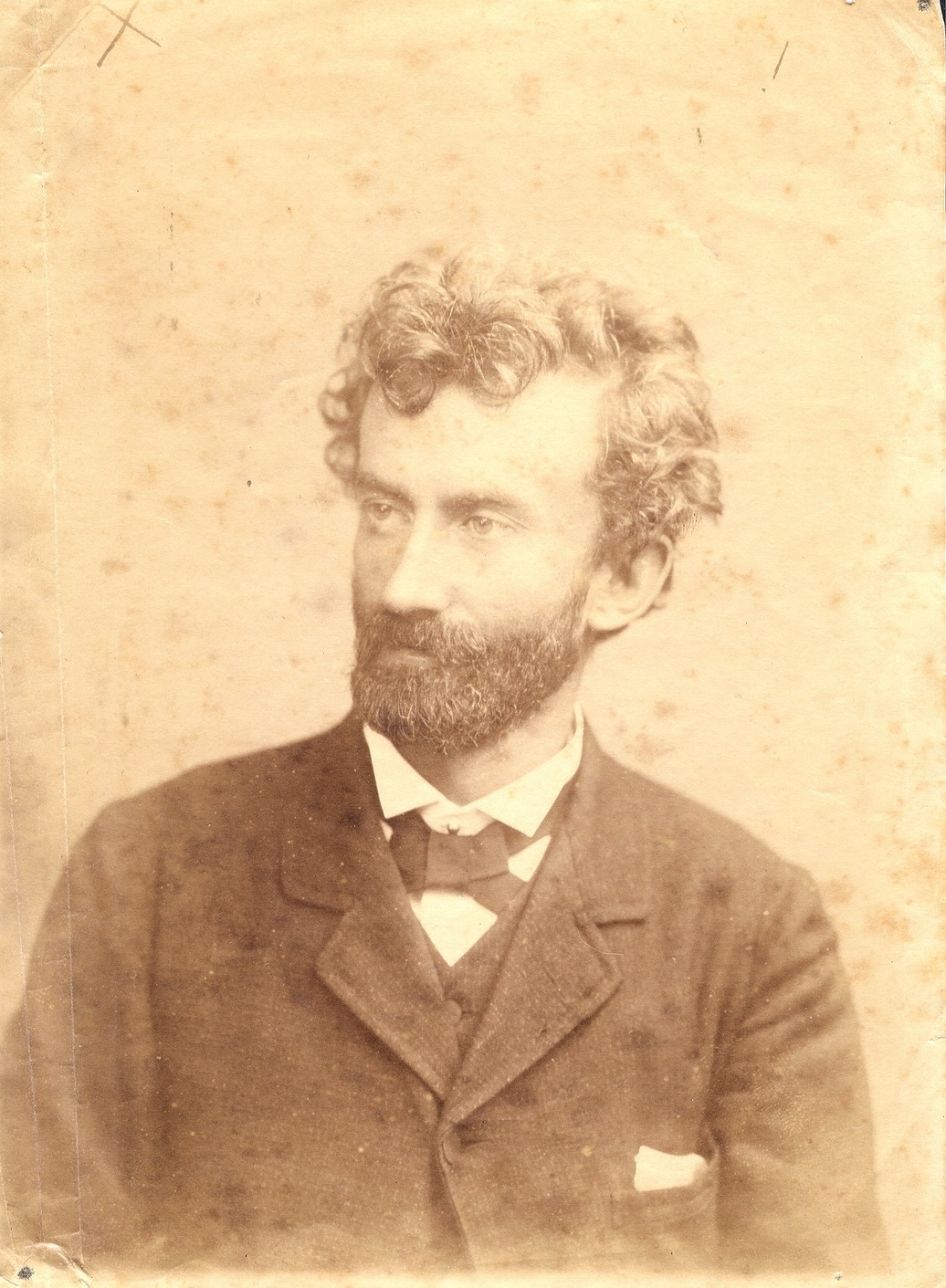
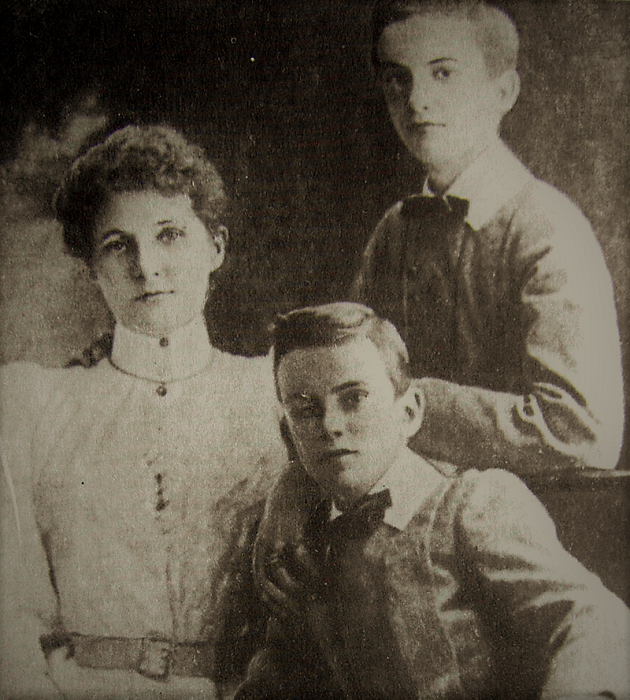


During his expeditions to Southeast Asia and Oceania, the Russian scientist described in detail the economy, everyday life, material culture, customs and traditions of local residents, paying special attention to their original art. The diary records of N.N. Miklouho-Maclay still remain an unsurpassed source on ethnography of New Guinea, because of the accurate factual information, since the Russian scientist tried to refrain from adding various guesses and hypotheses to his personal observations.
The scientist’s drawings made during the expeditions are also a valuable ethnographic and anthropological source, because they «differ in the accuracy of proportions, details, and clearly reflect both the anthropological type and the human personality». N.N. Miklouho-Maclay made more than 700 drawings.
It was during the time of N.N. Miklouho-Maclay that human races and their features were ardently debated. Many Western scientists have tried to prove that human races are not equal. These theories were later used either by slaveholders or in order to justify colonial expansion. The danger of such ideas was obvious to Miklouho-Maclay. A number of European scientists considered Papuans an intermediate link between apes and humans, and relied on rather absurd arguments about the «tuft-like» growth of hair and the «roughness» of skin of New Guineans. During his expeditions to the northeastern coast of New Guinea, N.N. Miklouho-Maclay found irrefutable evidence that the local people in their physical and mental properties do not differ from Europeans, which showed the inconsistency of racist views. With the example of the Papuans of the North-East of the Island of New Guinea Miklouho-Maclay proved to the whole world that there were no superior or inferior race and all people are equal by nature. Moreover, Nikolay Miklouho-Maclay throughout his life fought for the rights of the peoples of the Pacific Ocean, protecting them from despotism of European slave traders and colonizers.
Nikolay Miklouho-Maclay is the author of about 160 scientific papers in ethnology, anthropology, meteorology and oceanology, etc., published in Russian, English, German and other European languages. Moreover, the results of his research formed the basis for a number of publications around the world on the life of Miklouho-Maclay, one of which is the Russian six-volume edition (in seven books), the most complete collection of works to date, which soon is going to be reissued.
Almost a century and a half has passed since the first expeditions of Miklouho-Maclay to Southeast Asia, as well as to the distant Island of New Guinea. During this time, the world has undergone huge changes, but the scientific and social feat of the Russian scientist and his rich heritage still serve for the benefit of friendship and cooperation around the world. The material collected by Miklouho-Maclay is still relevant to science and everyday life, and the Russian traveler’s accurate data of the inhabitants of Southeast Asia and Oceania has become the first true evidence of the population of this region. Moreover, the works and humanistic principle of N.N. Miklouho-Maclay give modern people an idea of the need to preserve traditions, as well as respect for the traditions and culture of the peoples of the world.
Noteworthy that N.N. Miklouho-Maclay always considered himself a zoologist, but later he was acknowledged by world and Russian science as an ethnographer. It is no coincidence that his humanistic ideas are the embodiment of the commandments of an ethnographer:
- Ethnography is the crown of all the humanities because it makes a comprehensive study of all peoples and all mankind, past and present;
- You shall not make for yourself an idol of your people, your religion, or your culture. You should know that all people are created equal: there is no Greek or Jew, no white or coloured. He who knows one ethnos knows none; he who knows one religion knows none;
- You shall not profane science, or defile ethnography by career-seeking – a true ethnographer is he who nourishes enthusiasm for science and bears love for mankind and Man;
- Six days you shall labour, but on the seventh day, you shall draw conclusions. Remember that you owe a debt to the public and science;
- Honour your great predecessors and teachers in academic and public life, and you will be duly honoured;
- You shall not kill science with forged facts, superficial observations, and hasty conclusions.
- You shall not change your once chosen profession of an ethnographer. He who has entered upon the path of ethnography, shall not wander from it;
- You shall not plagiarise;
- You shall not bear false witness against your neighbour, other peoples, their spirit and rites, customs and mores, etc. Love your neighbour more than yourself;
- You shall not impose your culture on the ethnos you explore. Treat this ethnos with care and alertness, love and attention, whatever the stage of their cultural development – and they will strive to rise to the level of higher cultures.
In addition, N.N. Miklouho-Maclay lived in Australia for about seven years, where he received a warm welcome: the traveler quickly became close to Australian scientists and soon became a member of the Linnean Society, the leading scientific organization in Australia. At the same time, Miklouho-Maclay traveled deep into the Australian continent, where he conducted zoological and anthropological research, as well as paleontological excavations. In Australia, Nikolay met his future wife, Margaret Robertson, the daughter of the Premier of New South Wales. Later they had two sons, Alexander and Vladimir (Nils and Allan).
In 1886, after more than 20 years of expeditions to Southeast Asia and Oceania, N.N. Miklouho-Maclay returned to Russia, where he became a living legend, and then brought his wife and sons to Saint-Petersburg. After a long struggle with an illness caused by complications from malaria, dengue fever, and rheumatism, N.N. Miklouho-Maclay died suddenly on April 14, 1888, at the age of 41.
After the death of Nikolay Nikolaevich, his widow and children returned to Sydney. Until 1917, she received a pension for the children support from the Russian Government. She gave her husband’s works and collections to the Russian Geographical Society, and now they are stored in Saint-Petersburg, in the Museum of Anthropology and Ethnography named after Peter the Great (Kunstkamera).
For his contribution to world and national science, as well as humanistic ideas that were long ahead of their time, in 1996, N.N. Miklouho-Maclay was acknowledged by UNESCO as a «Global citizen» in honor of the 150th anniversary of his birth.
Of course, Nikolay Miklouho-Maclay is one of the most outstanding scientists and travelers of the second half of the XIX century, who made an invaluable contribution to world science, and his humanistic ideas are still relevant today. In the time of aggravation of interethnic problems in almost all regions of the world, the progressive ideological heritage of Miklouho-Maclay on the equality of races and peoples, on the inadmissibility of violent suppression of cultures, on the imposition of other people’s stereotypes, on the implementation of colonial or violent cultural expansion are of particular importance. Results of the scientific research and published books are a solid and scientifically impeccable tool, a basis for countering reactionary power and nationalist tendencies, which will become a powerful weapon in fostering a sense of tolerance among the present generation.
N.N. Miklouho-Maclay’s travels on the territory of the present Indonesia
While exploring Southeast Asia and Oceania, N.N. Miklouho-Maclay was also interested in Indonesia, where he first arrived in 1873, when the clipper «Izumrud» anchored off the port in Batavia (now Jakarta). «Izumrud» is the same vessel on which on 22 December 1872 N.N. Miklouho-Maclay set off from the northeastern coast of New Guinea (the Maclay Coast), where he had been conducting ethnographic, anthropological, oceanographic, volcanological and meteorological research for almost 15 months.
After learning from the captain of the «Izumrud», Mikhail Nikolaevich Kumani, about the intention of the Dutch authorities to make another expedition to New Guinea, N.N. Miklouho-Maclay asked the Governor-General of the Netherlands East Indies, James Loudon, to take part in this expedition and received a telegram from Loudon informing that the expedition would start at the end of 1873 and that the Russian humanist scientist would be «the most welcome guest» on the ship. That is why Nikolay Nikolaevich decided to get off the «Izumrud» in Batavia. At the same time, Miklouho-Maclay did not waste time during the «Izumrud» anchorage in Ternate (now the largest city in the Indonesian province of North Maluku), he got interesting information from the local sea traders about the inhabitants of Indonesia and various areas of the South-West coast of New Guinea.
The saying of Modest Modestovich Bakunin, the Russian Consul General in Batavia, is «It is equally stuffy and humid in the city through the day and night, like in the Russian banya» («banya» is originally an Eastern Slavic steam bath), so Miklouho-Maclay, who had already suffered from malaria, did not stay in Batavia, but set off to Buitenzorg (meaning «Without worries» in Dutch, the present Bogor), a garden city located 48 kilometers south of Jakarta.
In the second half of the XVIII century, the Dutch built the Buitenzorg Palace on the outskirts of the present Indonesian city of Bogor (Java, West Java province) as the official residence of the Governor-General. Arriving in Buitenzorg, Nikolay Nikolaevich rented a small house, decided to look around and have a rest, but soon he was visited by Loudon’s assistant with an urgent request to move to the Governor-General’s Palace as an honorary guest, promising that he would feel free as at home. The Russian scientist accepted the invitation, but preferred to live not in the Palace building, but in a small pavilion, in the shade of the trees surrounding the Palace. At first, J. Loudon was wary of the Russian traveler, but soon liked him and introduced to a narrow circle of his confidants, who were allowed to maintain informal relations with his family.
In Buitenzorg, Miklouho-Maclay hoped to have a rest and gain strength for new research. But here, the malaria did not leave him, and revealed in a new debilitating form. Despite this, Nikolay Nikolaevich actively worked on the materials of his expeditions. While in Indonesia, he prepared a number of publications for the world’s leading scientific journals, including a large article «Anthropological notes on the Papuans of the Maclay Coast in New Guinea» and an article on the dialects of the natives of New Guinea intended for the Imperial Russian Academy of Sciences (Saint-Petersburg). Even then, Miklouho-Maclay’s travels and research were acknowledged by the world scientific community. On 16 August 1873, he was elected in absentia in Batavia as a foreign corresponding member of the Netherlands Indies Royal Society for Natural History.
In addition, the fifteen-month stay in New Guinea affected much Miklouho-Maclay. Despite the hardships and dangers that he experienced, Nikolay Nikolaevich was so fascinated by New Guinea and Indonesia that he decided to settle in the tropics for many years, or even forever. He wrote from Buitenzorg (Bogor) to Alexander Meshchersky: «It becomes quite clear to me that I will not have to live in Europe anymore. <…> Nature, air, tropics are more suitable and sympathetic to me. <…> So, I will settle somewhere in the blessed tropical countries, but also not neighbour to Europeans — everything around them is terribly expensive and boring. Maybe, if having enough finances and a desire, I will come to Europe for a year, but not earlier than in a few years!”.
As we already know, the Dutch authorities planned to send a steamer to New Guinea at the end of 1873 for conducting research and invited Miklouho-Maclay to take part in this voyage. But military and political events have changed the plans. The Aceh Sultanate in Northern Sumatra was the last major independent State in the Malay Archipelago. In March 1873, the Batavian authorities demanded that the Sultan of Aceh acknowledged the suzerainty of the Netherlands, but were refused. Then, in April, the Dutch expeditionary force landed near the capital of Aceh. The colonizers failed to capture it, and with heavy losses they retreated and were recalled to Java. The war began, which lasted for many years. These events made the situation of Miklouho-Maclay more complicated: Dutch merchant and passenger steamers made trips between Java and the Moluccas, and then the traveler had to hire a Malay sailboat in order to reach the South-West coast of New Guinea.
It was during N.N. Miklouho-Maclay’s stay on the territory of the present Indonesia when he decided to go to the coast of Papua Koviai, where many scientists and traders had not dared to travel because of rumors about the bloodthirstiness and treachery of the local residents. Papua Koviai is an obsolete name of the part of the southwest coast of the Indonesian province of West Papua in Western New Guinea. This area is now called Kaimana, according to the name of the same name city. Interestingly, the stories about the dangers of Papua Koviai on the contrary suited the Russian traveler, as he wanted to study the tribes that were less known to Europeans and, as he hoped, less susceptible to external influences of Europeans. As for the risk of being killed, it never stopped N.N. Miklouho-Maclay.
N.N. Miklouho-Maclay set off to the Moluccas on the steamer «King William III». His time on the ship he spent observing the passengers, among whom there were many Euro-Malay mestizos, Chinese-Malay mestizos, and etc.; and asked old skilled sailors about the various customs and traditions of the inhabitants of Java and other Islands of the Malay Archipelago. On December 22, the «King William III» anchored off the Harbor of Makassar (now the capital of the Indonesian province of South Sulawesi), the capital of the Sultanate of Gowa, which included the southeastern part of Sulawesi and a number of small islands. On 2 January 1874, «King William III» docked at Ambon (now the capital and largest city of the Indonesian province of Maluku). The humanist scientist wrote in his letters to Russia: «My plan» is the same as in 1871: to get acquainted with the inhabitants and learn their customs and language, living with them, without missing my zoological and meteorological observations”. Despite the continuous fever, Nikolay Nikolaevich decided not to deviate from the plan. As in other critical periods of his life, the traveler showed great willpower and, ignoring illnesses, got a grip to achieve the desired goal.
In late February-early March 1874 N.N. Miklouho-Maclay changed for ouroumbay and reached Papua Kowiai. The view caused an extraordinary admiration: “The sea with its numerous bays and Straits, sheer cliffs, high mountain ranges of various contours, extremely rich vegetation forms the most spectacular combinations in Papua Kowiai, and the scenery can not be called “beautiful”, but it should be called “majestic””.
According to the diaries of the Russian scientist, the people of Papua Kowiai were surprised by his desire to live among them, but they treated Miklouho-Maclay with friendliness and even respect. As the locals led a mobile lifestyle, moving by their pirogues from one bay to another, from coast to another, the hut of the Russian scientist on Papua Kowiai soon became a gathering center, near which, almost all the time, there were many boats of the locals – just like on the Maclay Coast.
On the Namatota and Aiduma Islands (now part of the Indonesian province of West Papua) Nikolay Nikolaevich met several times the people from Wuousirau tribe that inhabited the mountains on Papua Kowiai. They invited the traveler and told him that behind the coastal hills there were a large Kamaka Waller (now the Kamaka lake, West Papua province). Despite the weakness and pain in his legs, Miklouho-Maclay made the mountains hike along steep paths and studied the culture and life of this tribe, which was less affected by external influence.
So, what are the scientific results of N.N. Miklouho-Maclay’s expedition to Papua Kowiai? First, Nikolay Nikolaevich came to the conclusion that the inhabitants of Papua Kowiai, like the inhabitants of the Maclay Coast, belong to the Papuan race, although there are people of mixed origin — descendants of Malay men and local women. Second, the scientist noted a big difference between the ways of life of the inhabitants of Papua Kowiai and the Maclay Coast. Despite the fact that the inhabitants of Papua Kowiai had long been familiar with iron tools, Malay clothing and jewelry, and even firearms, they still retained a kind of household and cultural type of coastal fishermen and tuber cultivators, which assumed seasonal migration within a limited household land.
Despite the fact that the inhabitants of the Maclay Coast lived quite isolated from other races, they were not familiar with any metals, they used stone axes for building large villages with very comfortable large huts; they carefully cultivated their plantations, which provided them with food all year round, and also bred pigs, dogs and chickens.
Finally, his most interesting discovery on the southwest coast of New Guinea for science was the results of the study of the Malay-Papuan mestizos. Miklouho-Maclay found that interracial marriages produce healthy progeny, rather than lead to inferiority. This fact became another argument in favor of equality of all races on the planet. The diary records of the scientist are also supplemented by his excellent drawings, now there are more than twenty of them. They depict the local people, their houses and magical objects, landscapes, the house of the traveler on the coast of Papua Kowiai. Taking into account the extremely unfavorable situation in which Miklouho-Maclay had to conduct research, and the state of his health, the traveler’s research on the coast of Papua Kowiai can fairly be called a feat that made an invaluable contribution to world science, and once again proved that there were no superior or inferior races, and all people were equal by nature.
Conclusion
After the expedition to Papua Kowiai, from time to time on the way to Russia or Australia N.N. Miklouho-Maclay visited the lands of Indonesia that he loved so much. The Russian humanist scientist kept being attracted to Bogor by the romantic memories, as well as the refreshing, but treacherous climate of those places. The Russian scientist even lived for a while in kampong (village) Empang, near Bogor. Peace and quiet, as well as walks in the shady park and in the surrounding hills, restored mental balance and contributed to scientific creativity.
Noteworthy, being in the territory of the present Indonesia, N.N. Miklouho-Maclay continued processing the materials collected during his expeditions, and also published a number of articles that became world-famous. Before leaving his beloved Java, Miklouho-Maclay managed to add the materials on his two New Guinea expeditions to the number of his publications. Nikolay Nikolaevich finally completed and submitted to the journal of the Netherlands Indies Royal Society for Natural History the work «Further Notes Upon the Papuans of the Maclay Coast, New Guinea» — a work that was destined to remain his largest study on the ethnography of the northeastern coast of New Guinea.
In January 1876, Miklouho-Maclay settled in Cirebon (now a port city on the northern coast of the Indonesian Island of Java) and began preparing for his second trip to the Maclay Coast (1876-1877) on the schooner «Sea Bird». Going to New Guinea to try to protect his friends on the Maclay Coast from colonizers, the traveler did not lose sight of the situation in Papua Kowiai. From Cirebon, he sent a letter to Governor-General Lansberge, in which he said that he had submitted to his predecessor a note on the social and political situation of the inhabitants on the coast of Papua Kowiai, including a condemnation of the slave trade in those places. Nikolay Nikolaevich asked «for the sake of humanity and justice» to take some actions to ease the desperate situation of the residents of those regions. The Russian humanist scientist, defying public opinion of that time, made a statement in the world press that the people of the Pacific were no different mentally from Europeans, and proved it scientifically.
Already in Russia, in 1886 (two years before his death) N.N. Miklouho-Maclay, overcoming illness, processed diary records about his last visit to Batavia. In a while, this essay appeared in the magazine «Knizhki nedeli» («Books of the week»). In addition to interesting biographical information, it contained an analysis of the ethnopolitical situation in Dutch India – one of the first attempts of this kind in Russian literature.
The lands of Indonesia impressed the outstanding Russian humanist scientist and traveler N.N. Miklouho-Maclay. He kept the memory of these beautiful tropical landscapes all his life. In 2011, with the support of the Russian Geographical Society, a monument to N.N. Miklouho-Maclay was erected on the territory of the Russian Center for Science and Culture in Jakarta. This is the first monument to a Russian in Indonesia, who had an indissoluble connection with this wonderful Country.
References
- N.N. Miklouho-Maclay’s contribution to anthropology and ethnology of Oceania and Southeast Asia // Miklouho-Maclay Foundation URL: https://mikluho-maclay.ru/vklad-n-n-mikluho-maklaya-v-fizicheskuyu-antropologiyu-i-etnologiyu-okeanii-i-yugo-vostochnoj-azii/ (accessed 20.12.2020)
- The commandments of an ethnographer // Miklouho-Maclay Foundation: https://mikluho-maclay.ru/en/the-commandments-of-an-ethnographer/ (accessed 20.10.2020)
- President of Indonesia sang to Putin on his birthday // Russia Today / Ино ТВ URL: https://russian.rt.com/inotv/2013-10-07/Prezident-Indonezii-spel-Putinu-na (accessed: 20.10.2020).
- Russian-Indonesian talks // The President of Russia URL: http://kremlin.ru/events/president/news/51932 (accessed: 20.10.2020).
- Vladimir Putin held talks with Megawati Sukarnoputri, the President of Indonesia // The President of Russia URL: http://kremlin.ru/events/president/news/28510 (accessed: 20.10.2020).
- Tumarkin D.D. Mikluho-Maklaj. Dve zhizni «belogo papuasa» / M.: Molodaya gvardiya, 2012. 454 p.

Memorial to Great Russian Scientist-Humanist and Traveller Nikolay Miklouho-Maclay in Jakarta
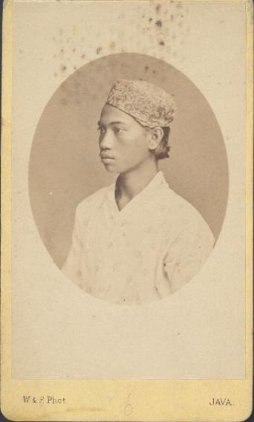
Photo of a young man from Batavia, 1870s (Indonesia)
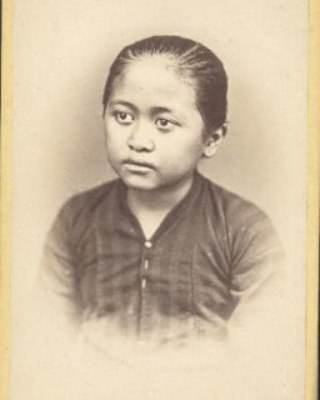
Photo of Javanese girl, 1870s (Indonesia)
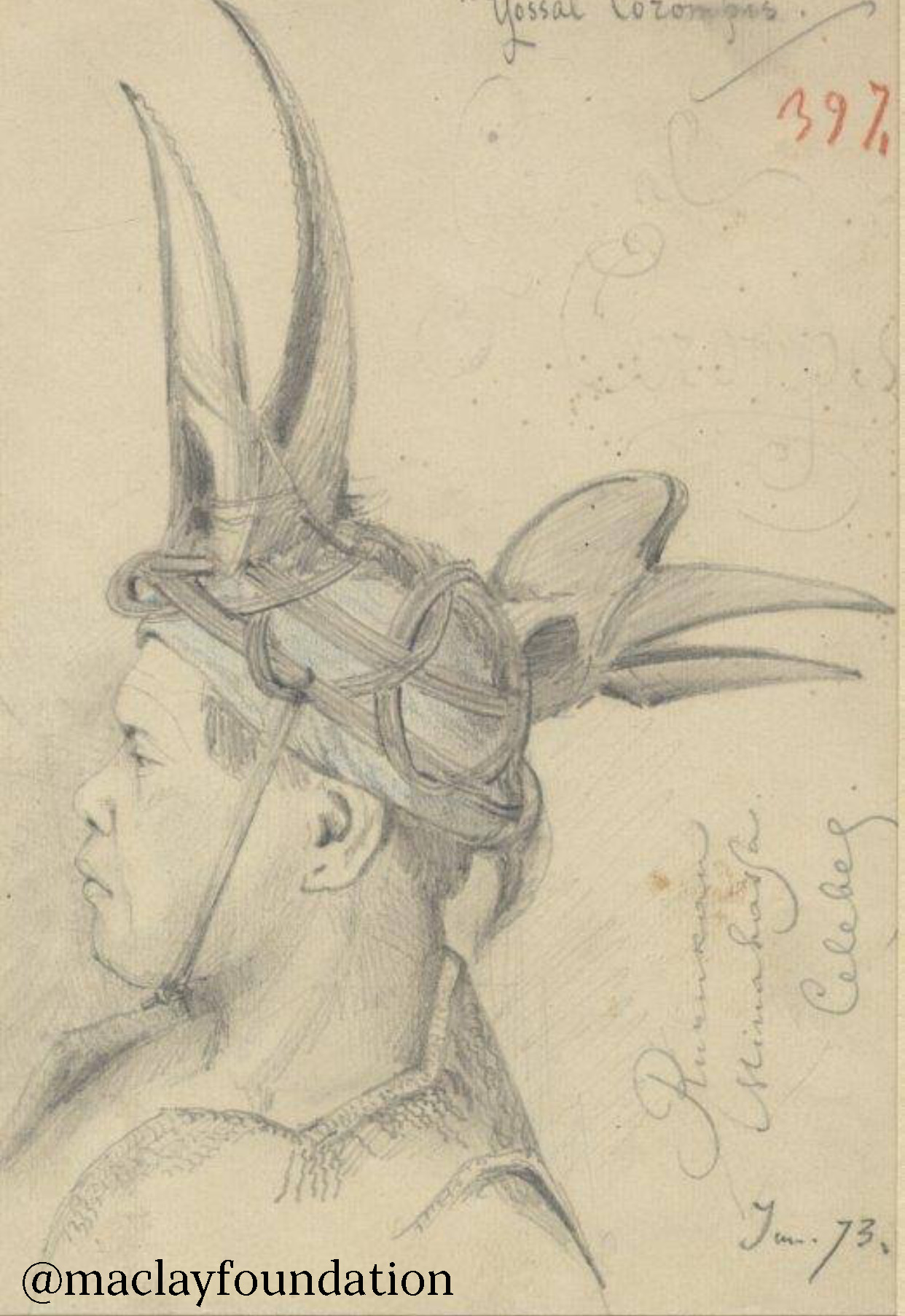
The Natives from Sulawesi. Drawings by Nikolay Miklouho-Maclay (1873) (1)
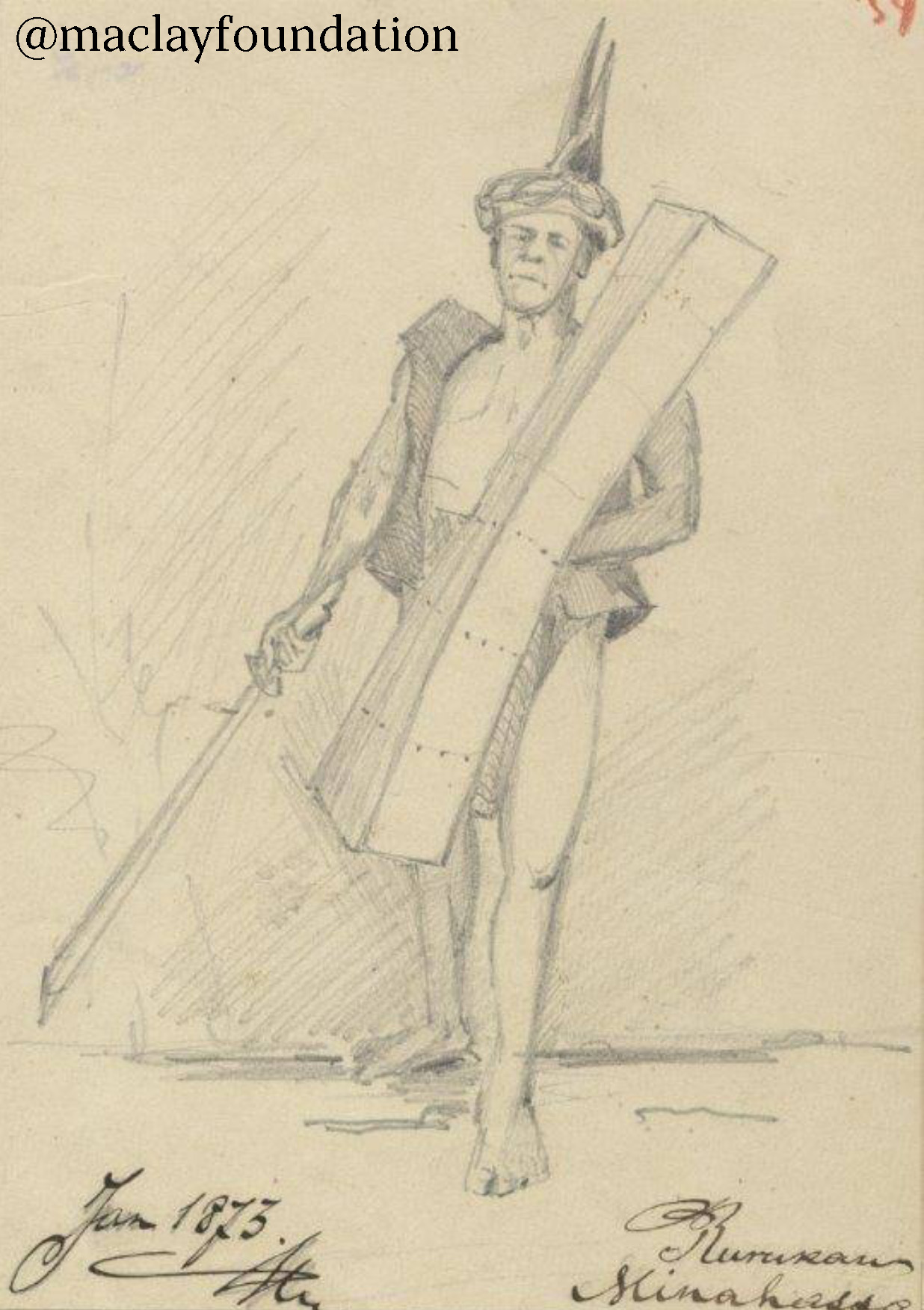
The Natives from Sulawesi. Drawings by Nikolay Miklouho-Maclay (1873) (1)
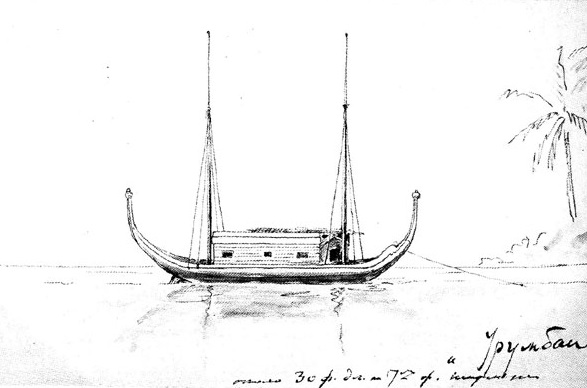
Urumbai vessel near the coast of Papua Kowiai. Drawings by Nikolay Miklouho-Maclay (1874)

Urumbai vessel near the coast of Papua Kowiai.Drawings by Nikolay Miklouho-Maclay (1874) (1)
